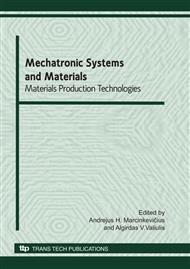p.1
p.7
p.13
p.19
p.25
p.31
p.37
p.43
Effect of the Unit Pressure on the Selection Parameters of Intermetallic Coatings NiAl and Ni3Al after Plastic Working
Abstract:
Modern materials on intermetallic matrix are in the scope of research of many scientific – research centers in Poland [1]. Intermetallic systematic alloys containing aluminium have high resistance to oxidation, abrasive corrosion and fatigue as well as heat resistance. That is why they are applied in the production of machine parts used in hard service conditions (internal combustion turbine blades, exhaust valves, turbo-blower rotors) [2]. Intermetallic coatings can be obtained by means of plasma spraying. Thermal spraying technology is widely used due to the possibility of increasing the service properties in surface layers (strength property, tribological, anti-corrosive and decorative property) as well as coating application on machine parts elements, on tools for plastic working (forging moulds busters, piston rods, gear wheels teeth, crank journals, valve seats, and combustion engine cylinders) [3, 4]. NiAl and Ni3Al coatings are characterized by high fatigue resistance, heat resistance and considerable corrosion resistance [5]. Coatings obtained by thermal spraying have high surface roughness. Thus, subsequent plastic treatment is advisable for plasma-sprayed intermetallic coatings. Therefore it is vital to define to what extent the change of unit pressure will influence reduction of surface roughness of intermetallic coatings. For this purpose experimental upsetting research was carried out on C45 steel samples having NiAl and Ni3Al coatings for the following unit pressures p = 500 MPa, p = 800 MPa, p = 1100 MPa.
Info:
Periodical:
Pages:
19-24
Citation:
Online since:
June 2010
Authors:
Keywords:
Price:
Сopyright:
© 2010 Trans Tech Publications Ltd. All Rights Reserved
Share:
Citation:


